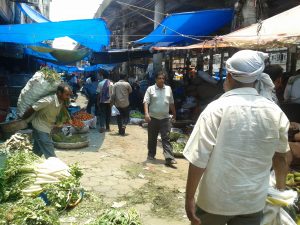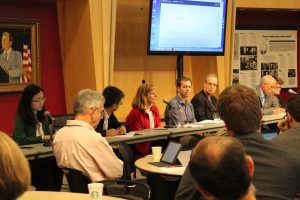Monthly Archives: October 2017
News
NEW STUDY: Cities Can Play Important Role in Reducing Environmental Impact of Food Systems
A new study published by SRN researchers in the the journal Environmental Science & Technology introduces a methodology for understanding the impact that city-level policy can have on reducing the overall environmental impact of food systems. See complete findings here.
On global and national scales, the food system is known to have substantial environmental impact, with estimates as high as 85% of global water use and 30% of global greenhouse gas emissions. Yet cities, despite being such large centers of population and food use, remained largely absent from the discussion of how to mitigate these large environmental impacts. The food system has traditionally not been considered a common concern of municipalities, particularly in comparison to other infrastructure sectors, thus the metrics and tools to assess city-level change within the food system are substantially lacking.
Only recently have cities begun reemerging as players in the global food system grappling with food system concerns ranging from health and nutrition of their residents, equity of access, resilience, and environmental sustainability. Evidence of this is seen in recent efforts by global food organizations, including the United Nations Food and Agriculture Organization’s Food for the Cities, C40’s Food Systems Network and the Milan Food Pact, all working to mobilize city-scale food system actions. Examples from the Minneapolis-St. Paul Metropolitan area include the Minneapolis Food Policy Council, Homegrown Minneapolis, a non-profit organization, as well as the City of St Paul through its work to improve food access.
Yet with such a diversity of urban food concerns, the science is lacking to assess the tradeoffs and co-benefits of various city-level actions that affect food policy and food systems. For example, if a city aims to promote a particular diet for improved health, does this complement or conflict with efforts to lessen overall environmental impact?
While the water, energy/greenhouse gas (GHG) and land impact of the global food system has been studied on national and global scales, this paper focuses on actions taken at the city scale that have received little attention. The paper presents a systems methodology to address the important question of: what is the extent to which city-scale actions shape the overall food system’s environmental impact, specifically in terms of GHG, water, and land?
The methodology helps to identify which food systems strategies are co-beneficial and where tradeoffs must be considered in terms of water, energy, GHG and other social impacts (i.e. greater equity, increasing nutrition). The methodology presented is applicable to any city with the requisite data. As cities increasingly emerge as prominent players in the global food system, this research helps cities to understand, quantitatively, their actions in the context of resource constraints and planetary boundaries.
Applied to Delhi India, the work explores future urban food scenarios related to: a) diet-related equity and health; b) sustainable diet change; c) greater local food production through various modes of urban agriculture (soil-based, vertical); d) improved food waste management and e) cooking fuel interventions.


The analysis demonstrates that city-scale action can rival typical food policy interventions that occur at larger scales, although no single city-scale action can rival in all three environmental impacts. In particular, improved food-waste management within the city (7% system-wide GHG reduction) matches the GHG impact of pre-consumer trans-boundary food waste reduction. The systems approach is particularly useful in illustrating key tradeoffs and co-benefits. For instance, multiple diet shifts that can reduce GHG emissions have trade-offs that increase water and land impacts. Vertical farming technology with current applications for fruits and vegetables can provide modest system-wide water (4%) and land reductions (3%), although implementation within the city itself may raise questions of constraints in water-stressed cities, with such a shift in Delhi increasing community-wide direct water use by 16%. Improving the nutrition status for the bottom 50% of the population to the median diet is accompanied by proportionally smaller increases of water, GHG, and land impacts (4%, 9%, and 8%, system-wide): increases that can be offset through simultaneous city-scale actions, e.g., improved food-waste management and vertical farming technologies.
The study, “What Is the Contribution of City-Scale Actions to the Overall Food System’s Environmental Impacts?: Assessing Water, Greenhouse Gas, and Land Impacts of Future Urban Food Scenarios” is published in the journal Environmental Science and Technology by Dana Boyer (PhD Candidate, Science, Technology and Environmental Policy) and Anu Ramaswami (Professor, Denny Chair) of the Center for Science, Technology and Environmental Policy at the Humphrey School of Public Affairs. See the complete findings here.
News
NEW STUDY: Role of Cross-Sector Strategies in City Efforts to Reduce GHG Emissions, Improve Health
Based on “bottom-up” emissions data from 637 cities in China–the most comprehensive data set of its kind–a new study published in the journal Nature Climate Change by SRN researchers models the role of cross-sector strategies in city efforts to reduce GHG emissions.
The study specifically considers the aggregate GHG emissions impacts and local health impacts that could be generated if cities deployed strategies of cross-sector industrial symbiosis to capture and re-use “waste heat” and other other byproducts of industrial activity located in or near cities. The study has key implications for:
- 1) quantifying what cities can and cannot do to contribute to national aggregate CO2 mitigation efforts
- 2) quantifying what city-level CO2 mitigation efforts mean for local health benefits
- 3) understanding the potential impact of circular economy policies and urban design strategies that encourage cross-sector reuse of “waste heat” and other industrial byproducts
The remainder of this post is excerpted from an article posted on the Humphrey School of Public Affairs news page. See the original article here.
Concerns over global climate change and local air pollution have led many cities around the world to get creative in their efforts to reduce the use of fossil fuels. They’re going beyond conventional single-sector strategies such as energy-efficient buildings and power plants to look at innovative ways to capture waste heat from industries and businesses—from cement plants, to pulp and paper mills to grocery stores—and pipe it to homes and buildings up to 30 kilometers away.
Some cities are also reusing waste materials from industries in urban construction as a substitute for cement and other construction materials, helping reduce the demand for these materials.
Scientists use the terms “cross-sector strategies” and “circular economy strategies” to describe such novel approaches to urban infrastructure planning, which have several goals: to reduce material and energy use; to reduce reliance on fossil fuels; to improve air quality; and to improve the health of residents in urban areas, while simultaneously creating value from resources that were previously wasted.
New research by Professor Anu Ramaswami of the Humphrey School of Public Affairs at the University of Minnesota, published Monday in the latest online edition of Nature Climate Change, is the first to demonstrate just how successful these strategies would be, if widely adopted.
“Cities are the critical centers of change when it comes to taking action on greenhouse gases,” said Ramaswami, who led this study that looked at all 637 cities in China at the same time. “Our research shows there’s great potential for cities to reduce energy demand and carbon emissions by adopting cross-sector strategies, such as reusing industrial byproducts like waste energy, on a mass scale. And that means a better quality of life for residents. It’s a win-win.”
Professor Anu RamaswamiThe study finds that if all cities in China adopt these strategies, they would reduce greenhouse gas emissions by up to 36 percent—and at the same time, protect up to 57,000 people from dying prematurely due to poor air quality. Researchers base these findings on models that examine potential carbon reductions and the expected health improvements.
The study also found that the benefits varied from city to city, depending on the locale.
For example, two cities can take similar actions and reduce emissions or energy use by the same proportion, and see very different health and environmental outcomes, due to differences in how air pollution flows into and out of their cities from the surrounding areas.
Ramaswami noted that most research on greenhouse gas emissions up to this point has focused on what national-level policies can do, typically impacting individual sectors of the economy such as power generation, transportation, or energy-efficient building construction. This is the first of its kind to measure the impact of holistic urban planning in cities that encourages compact city development, eco-industrial parks, waste-to-value projects and district energy systems. Cities can readily adopt these practices, Ramaswami said, but they rarely get credit for them in terms of reducing greenhouse gases.
Since her study is the first to collect information at the city level, it’s a starting point for analyzing the science behind what cities can and cannot do to help reduce greenhouse gases on a nationwide basis, and what those steps mean for the local communities.
“The insights we gained from this study will inform how we design sustainable urban areas in China and elsewhere around the world in the future,” said Ramaswami. “That’s important because we expect to see another 2.5 billion people living in cities by 2050, with most of that population growth in Asia and Africa.”
Read the complete findings.
The study was conducted in collaboration with researchers at the Georgia Institute of Technology, Yale University, Tsinghua University, and Shanghai University.
The collaborations were enabled by a Partnership for International Research and Education (PIRE) grant from the National Science Foundation (NSF). The PIRE project concentrates on reducing greenhouse gas emissions from cities, while addressing broader sustainability goals such as economic development, water scarcity, environmental pollution, and public health. Several of the study authors are current affiliates with the Sustainable Healthy Cities Network, supported by an NSF sustainability research network grant.
Ramaswami is the Charles M. Denny, Jr., Chair of Science, Technology, and Environmental Policy (STEP) at the Humphrey School of Public Affairs. The STEP program integrates science with public policy, community action, and multi-sector governance.
News
100+ Attend Sustainable Healthy Cities Workshop on Distributed Infrastructure Futures
On August 28th and 29th, the Sustainable Healthy Cities Network hosted 100+ workshop participants at the Humphrey School of Public Affairs at the University of Minnesota including researchers, graduate students, city/regional government representatives, policy organizations, and industry representatives to discuss distributed infrastructure systems and their role in delivering sustainability outcomes in cities.

Participants engaged with research findings spanning multiple urban infrastructure sectors—including green infrastructure, urban food systems, transportation, energy, and water/wastewater. Workshop discussions centered on considering the policy and practice relevance of key findings from network researchers to inform urban sustainability decision-making.
The conversation covered topics including : 1) the appropriate scale and jurisdiction for considering the in-boundary and trans-boundary environmental impacts of cities, 2) the optimal mix of new localized and existing centralized infrastructure systems to maximize resource efficiency and sustainability outcomes, and 3) the challenges of financing and encouraging the adoption of distributed infrastructure technologies.

City representatives from Atlanta, Austin, Denver, Detroit, Durham, Fort Collins, Minneapolis, New York City, Saint Paul, Tallahassee, and Visakhapatnam (India) participated in the two day workshop, as did representatives from national organizations including ICLEI, ICMA, and Star Communities. The workshop also benefited from the participation of industry partners from Ecolab and Xcel Energy.
Stay tuned for the release a workshop outcome document later this fall summarizing workshop discussions and highlighting current trends in science-policy interface on issues of distributed infrastructure for urban sustainability. The document is slated for released in November 2017.




